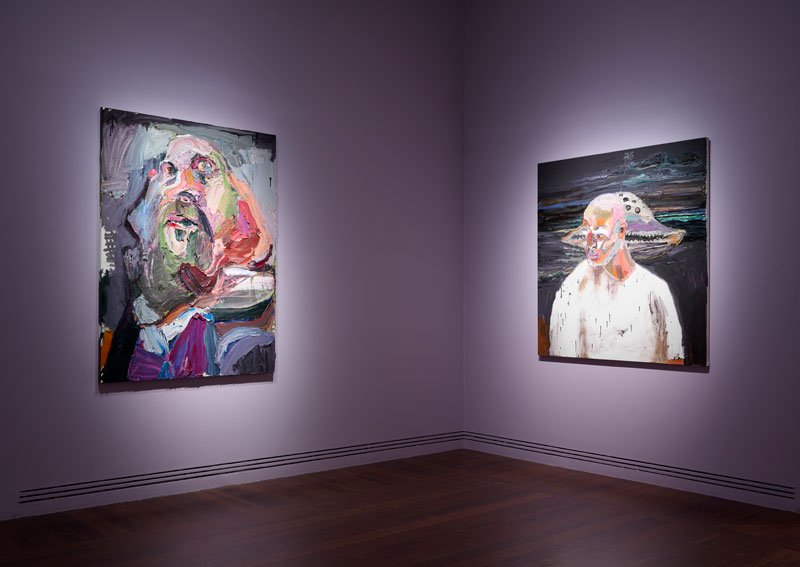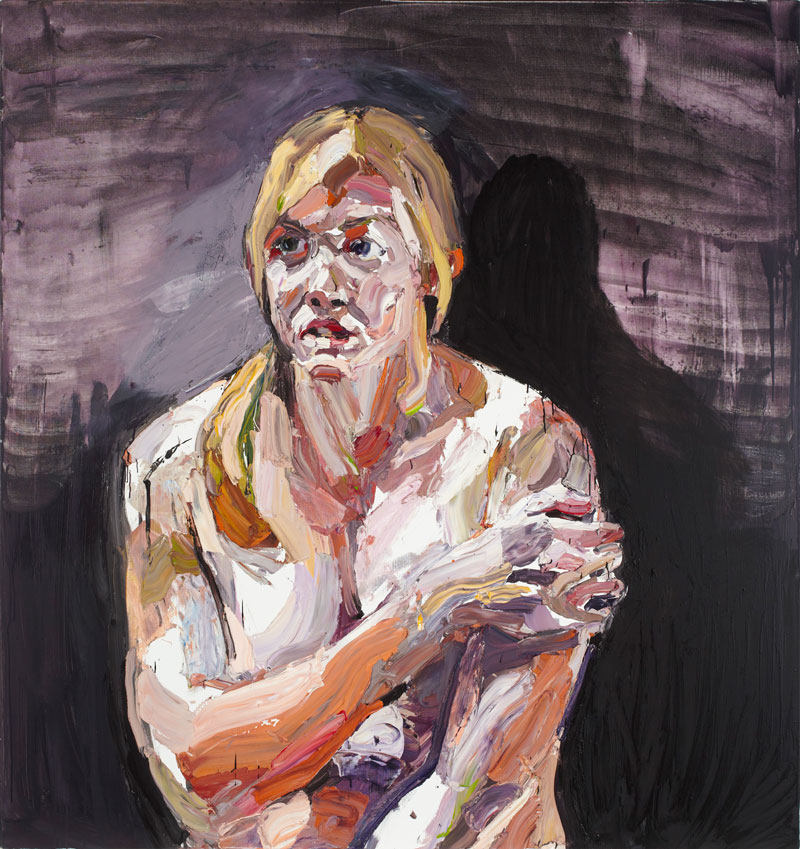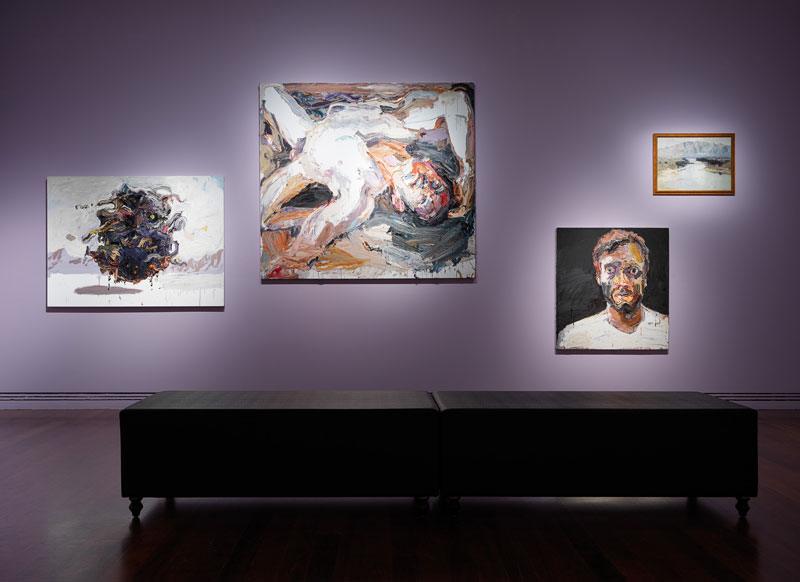.jpg)
Budgies, burgers and the beloved Holden Torana, Ben Quilty’s now familiar early icons fill the entry space of the Art Gallery of South Australia in Quilty – the artist’s biggest survey show to date. Lisa Slade, AGSA’s Artistic Director, Public Programs, has curated this exhibition featuring 70 of her mate Ben’s works. Her independent selection, mostly draws on his paintings from the last ten years in what is a sequel to Ben Quilty Live (University of Queensland Art Museum, 2009), also curated by Slade, with its ruminations on petrol-headed, booze-fuelled male rites of passage that reflected Quilty’s “coming-of-age.”[1] Quilty is larger in scale, subject and ambition.
In 2019, Quilty has become the closest thing Australia has to a celebrity artist, and it is near impossible to experience his survey show without this colouring. His charismatic persona and forthright political opinions – spanning the historical treatment of Indigenous Australians to the current global refugee crisis – have made him an idol of artistic virtue, the mainstream media responding to Quilty with hagiography. See photographic allusions to Christ on a recent cover of the Good Weekend.[2] At the opposite extreme you will find “not-a-racist-but” tabloid blow-hard, Andrew Bolt who dubs him the “politically fashionable” face of the left-wing.[3] Like Adam Cullen’s brilliant construct of the archetypal Australian “wild man” painter used to manipulate the press and public, Quilty’s success is an easy biographical hook – Aussie masculine bloke paints sensitively about masculinity.
In the cardinal words of Jimmy Barnes, another epitome of reformed Australian manhood: “he’s a simple man, with a heart of gold, in a complicated land.”[4] But how complicit is Quilty in his own myth-making? Certainly Quilty welcomes his mainstream status to strengthen his platform for political dissent. And perhaps this fame says more about our celebrity culture than it does about the artist himself. At a time when the medium of painting must justify its contemporary relevance and the biography of an artist may matter more than the paintings themselves, we must ask ourselves, what role do Quilty’s paintings play in the “post-medium” contemporary condition?

Quilty is a critical citizen, an artist and an activist, steeped in the current socio-political circumstances of fake news, xenophobic terror attacks, the rise of White Nationalism, toxic masculine behaviours and the equally shocking male suicide statistics in Australia. More Goya than party-political, at his best Quilty’s paintings are a true expression of the soul, reflected in his Myuran Sukumaran painterly empathies and his 2011 After Afghanistan nude portrait series in which he illustrates the strengths, fears and weaknesses of this pared-back humanity. Just as New Zealand Prime Minister, Jacinda Arden established kindness as a key principle of government policy, Quilty describes his work as being about “compassion and empathy” in the hope that it will push these principles “to the front of national debate.”
Reflecting on the status of contemporary painting, in her recent book The Love of Painting (Sternberg Press, 2018), Isabelle Graw breaks down the concept of painterly “vitalistic fantasies”, suggesting that paintings are “quasi subjects” because of their specific materiality. A painter’s personality manifests in their work through the obvious traces of working processes on the surfaces of their paintings. What endures in Quilty’s works is the palpable hand of his past emotions. His characteristic fat swathes of oil paint applied with muscular gestures convey Quilty’s stunning grasp of the expressive potential of this medium.

In the Afghanistan portraits, one is reminded of abstract expressionist Willem de Kooning who famously said that “flesh is the reason oil paint was invented.” There are also shades of Lucien Freud, grandson of Sigmund, not only in the virtuosity of Quilty’s thick paint application, but also in the way that he uses portraiture as a method of psychoanalysis. By virtue of this psychological penetration of his subjects, he elevates the experience of the viewer to the artist’s own. As with Freud’s nudes, Quilty’s intention is to convey a more truthful, often unflattering view of the human form. In Captain S after Afghanistan (2011), Quilty captures the internal darkness and fears of his sitter to communicate universal feelings of inadequacy, redundancy and psychosis. The artist’s previous explorations of the Australian myth of maleness and mortality are redefined in this series. ‘The opportunity to go and work with these young men in Afghanistan was almost the height of my exploration of the way masculinity plays itself out in our culture,” Quilty said in 2012.[5]

What also remains distinctive in Quilty’s practice is his vivid use of exaggerated colours associated with the human body. Red the colour of dried blood, the tawny peach of a freckle, the muddied turquoise of varicose veins or a swollen and stretched tattoo on burly, tanned flesh. Purple, specifically lilac, appears in almost all of his works. Slade describes this colour as “a bruise two days in. It’s the colour of regret and contradiction, brutal and beautiful.”[6] The walls of Quilty are painted in modulations of this tone. Lilac is the antidote to another favourite colour of Quilty’s – cadmium orange. The two shades sit almost opposing each other on the colour spectrum. Cadmium orange is both quintessentially Quilty-now and the colour of the contemporary condition. It is the colour of prison jumpsuits, a high terror alert, and the skin of the current US president. It is also the colour of the abandoned life vests, washed ashore on the Greek island of Lesbos, and captured in a twelve-part series of works from 2016.
.jpg)
Perfectly conveyed in paint, each “death jacket” as Richard Flanagan calls them in his foreword to the catalogue publication (Ben Quilty, Penguin Books, 2019) is named after an individual who died by suicide after seeking refuge in Australia. There are minor quibbles to dispense with about this series. While the vests and by extension smears of high-vis tangerine are an important tool in signifying inhumanity and its repercussive fears and anxieties, the semiotics in this body of work are perhaps too crudely literal.
Since Clement Greenberg’s infamous denunciation of easel painting, the medium has been clouded with the idea that painting is dead because the most interesting things about it could be distilled more effectively in other media – photography, sculpture, film, performance, literature. This essential criticism is that contemporary painting can convey very little information, certainly not complex ideas. At best, you’re going to get a visual metaphor and many of Quilty’s metaphors have been challenged before in paintings by Juan Davila and Gordon Bennett and by non-painter Ai Weiwei. In Law of the Journey and the accompanying documentary film Human Flow, featured in the last Biennale of Sydney, Weiwei drives a far more imposing statement of the human impact of the global refugee crisis than either the life-vest series or The Island (2013) commissioned for the 2014 Adelaide Biennial, the largest painting in Quilty, that also surreptitiously interrogates this worldview of violence and displacement.
.jpg)
Less obvious in their politics and subject matter are Quilty’s Last Supper paintings of 2016–17, displayed in the previous room. Here, cadmium orange is woven throughout the abstracted, surrealist images of contorted bodies. This series explores the failings of democracy as our world leaders sit back and watch the planet burn – politically, socially, and ecologically. Here, painting becomes the means of expressing a violently emotional attitude towards life, a catharsis of sorts. This is what lends Quilty’s works a particular panache and allows the viewer’s perceptions to transform these flat objects into quasi subjects saturated with their creator’s life.
Quilty’s paint is slathered on with an even greater urgency and abundance. He trowels, drags, carves and rebuilds his turbulent three-dimensional surfaces. Their imposing scale intensifies the magnitude of the situation, further exacerbated by the heightened eyeline at which Slade has hung the works. This tactic applies to every room of this exhibition – AGSA’s atrium and café walls, included. One of Quilty’s burgers with-the-lot drips above Art Gallery Food + Wine, a sumptuous suggestive sell to hungry audiences. Although exposure to the Last Supper works before lunch would quell anyone’s appetite.
In an increasingly digital art world, the paintings of Quilty – engaged with social issues but also the essential wetness of the paint and the vivid materiality of colour – occupy a space that reinforces its appeal in the face of rampant insensitivity and brutalisation. Quilty’s paintings are a conduit for change and resistance. For the most part, Quilty’s works encourage empathy and compassion and it is through acting on these moral fibres that we can strive to do better.
.jpg)
Footnotes
- ^ Laini Burton, ‘Growing Pains – a Journey through Ben Quilty Live!’ in Art Monthly Australia, No. 224, October 2009, 25–27.
- ^ Brook Turner, ‘Ben Quilty on the burden of being Australia’s artist from central casting,’ in Good Weekend, The Sydney Morning Herald, 23 February 2019.
- ^ Andrew Bolt, ‘Ben Quilty and the war against white men,’ Herald Sun, 17 September 2018: http://www.heraldsun.com.au/blogs/andrew-bolt/news-story/63a56b43598a620750e5f0a28bcb3617.
- ^ Lyrics to ‘Working Class Man’ by Jimmy Barnes, 1985.
- ^ Ben Quilty, Australian Story, ABC, 28 June 2012.
- ^ Lisa Slade, “The colour of Quilty”, Ben Quilty, Penguin Books, 2019, p. 27.
